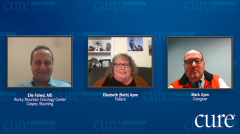
Multiple Myeloma: The Role of Free Light Chains
Beth describes the first relapse of multiple myeloma she experienced, and Elie Fahed, MD, explains what free light chains are and the role that they play.
Episodes in this series

Elie Fahed, MD: I was waiting to get my paperwork in order, and you were seeing a local doctor, Dr. Alan Grosset. He was helping you, and he did the bone marrow biopsy and then the MRI.
Mark Ayen: He wanted to do a bone marrow biopsy. At that point, Beth had had, over the years, what felt like a couple thousand bone marrow biopsies with all her follow-up appointments. She said, “No, I am not doing a bone marrow biopsy.” She basically negotiated with Dr Grosset to the point that she said, “OK, you can do an MRI. If you see something on the MRI, then we can talk about whether I will do a bone marrow biopsy.” They did the MRI, and then she did the bone marrow biopsy because they found something.
Elizabeth Ayen: He said to me—I didn’t even mention this, I had only mentioned some pain in my skull and in a couple of other places—when he came back, he said, “Are you having pain in your rib?” I said, “Yeah, but I don’t really talk about it because other practitioners kept telling me it was nothing.” He said, “Well, you have a nice size plasmacytoma there on your rib that we are going to have to do radiation on.” That is how it all came back. Then we did radiation on several of those sites. Then—
Elie Fahed, MD: You would get immediate relief from radiation, correct?
Elizabeth Ayen: Definitely. It worked really well for me at the low doses that they could do it at.
Elie Fahed, MD: Radiation therapy is one of the modalities we use to treat myeloma, and we use it quite a bit when treating plasmacytomas, which are isolated extramedullary lesions. Usually, radiation oncologists are able to target the radiation field to a small area, and plasmacytomas or myelomas are very sensitive to radiation. We have our patients’ pain resolved within a few days after starting treatment. We can do it to a certain point. We can cover a few areas at a time, but eventually the mainstay of treatment is systemic therapy, treatments that would go in your blood stream and treat your cancer wherever it is.
At that time, we met for the first time. I got my paperwork ready. I took over your care, and I noticed your free light chains were going up. Your case was very atypical, because you had nonsecretory myeloma. You had no M-spike. Your free light chains were going up, but you were barely higher than normal, so your lambda or kappa light chain would be about 5, 6, or 4, which is a variant of normal. For many patients I see, they have those numbers normally, but for you it was different.
Any increase in those numbers indicated more disease. This is a new test; it was not available when you were first diagnosed. Earlier on, we used to be able to measure, what we described earlier, as M-spikes. Now, every antibody, which is what plasma cells secrete, has either a kappa light chain or a lambda light chain. These are very small chains that consist of antibodies, which are what our body uses to fight infections. Whenever you have a myeloma or cancerous cells, you have an imbalance. Your body, theoretically, makes 50% kappa light chain and 50% lambda light chain. Whenever you measure those two and you divide them, you have a number around one. Whenever you have multiple myeloma, the myeloma cells usually secrete either kappa or lambda.
You have an abundance of one cell, so whenever you use a ratio, you have a ratio of 10, 20, 50. You clearly have one light chain that is much higher than the other. This is the way we know that something is wrong. We have been able to use it across the years to try to understand what is happening with your treatment, even though it was not a completely reliable indication of what was going on.
This transcript was edited for clarity.
